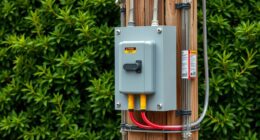If you’re seeking the best Wi‑Fi network sniffers of 2025, I recommend devices that support current standards like 802.11ax and operate across multiple bands, such as 2.4 GHz, 5 GHz, and 6 GHz. Look for features like external antennas for better range, protocol support for WPA3, and compatibility with your operating system. Specialized tools like Bluetooth and Zigbee sniffer modules, Ethernet testers, and long-range extenders further enhance monitoring. Keep exploring to discover how these tools can boost your network security and efficiency.
Key Takeaways
- The list includes Wi-Fi sniffers supporting latest standards like 802.11ax and multi-band frequency coverage for versatile monitoring.
- Devices feature advanced hardware options such as external antennas, PoE, and portable designs for extensive range and flexibility.
- Specialized protocol analyzers for Bluetooth, Zigbee, and RF modules enable in-depth security testing and wireless research.
- Network infrastructure tools like Ethernet switches and cable testers assist in comprehensive network setup and troubleshooting.
- The selection emphasizes secure, efficient monitoring with tools capable of decoding encryption protocols and capturing detailed traffic data.
ALFA Network AWUS036ACS Dual-Band AC600 USB Wi-Fi Adapter
Looking for a portable Wi-Fi adapter that delivers reliable long-distance performance? The ALFA Network AWUS036ACS Dual-Band AC600 USB Wi-Fi Adapter is perfect. It supports 802.11ac technology, offering speeds up to 150Mbps on 2.4GHz and 433Mbps on 5GHz. Its external dual-band antennas boost signal strength and coverage, reducing dead zones during streaming, downloads, or web browsing. Compact and easy to use, it’s compatible with Windows, macOS, and Linux, though Linux setup can be tricky. Ideal for penetration testers, network admins, or anyone needing extended range, it’s a versatile, budget-friendly choice for long-distance Wi-Fi connectivity.
Best For: users seeking a portable, reliable long-distance Wi-Fi adapter suitable for streaming, gaming, security testing, or extended coverage in various environments.
Pros:
- Supports dual-band 802.11ac with high-speed connectivity up to 150Mbps on 2.4GHz and 433Mbps on 5GHz
- External dual-band antennas enhance signal strength and coverage, reducing dead zones
- Compact, lightweight design with plug-and-play compatibility on Windows, macOS, and Linux
Cons:
- Linux support for monitor mode and packet injection can be challenging, requiring manual driver installation
- Driver support for newer macOS versions and M1/M2 chips is limited or unavailable
- Some users may need technical expertise to optimize performance and enable advanced features
SharkTapUSB Ethernet Sniffer
The SharkTapUSB Ethernet Sniffer stands out as an ideal tool for network professionals working with portable devices that lack dedicated Ethernet ports. It connects via USB 2 or USB 3, providing a seamless way to monitor Ethernet traffic on slim notebooks or netbooks. Its CAT-5 TAP port supports 10/100/1000 Mbps links, enabling passive, non-intrusive traffic capture. Thanks to copper repeater technology, it minimizes network impact while supporting PoE pass-through. With compatibility with Wireshark and easy setup, it’s perfect for troubleshooting, debugging, and diagnosing network issues on the go. Its compact design and reliable performance make it a must-have for modern network monitoring.
Best For: network professionals and technicians who need portable, non-intrusive Ethernet traffic monitoring on slim notebooks or devices without dedicated Ethernet ports.
Pros:
- Supports multiple Ethernet speeds (10/100/1000 Mbps) with passive, non-intrusive monitoring.
- Compact, lightweight design with easy plug-and-play setup compatible with Wireshark.
- Employs copper repeater technology to minimize network impact and supports PoE pass-through.
Cons:
- Potential packet loss when connected via USB 2.0 during high data flow scenarios.
- Occasional issues with packet blocking or interference during device boot or on PoE lines.
- Limited performance indication for high throughput situations, requiring careful monitoring during use.
Adafruit Bluefruit LE Sniffer Bluetooth Low Energy (BLE 4.0)
For anyone focused on analyzing Bluetooth Low Energy (BLE) communications, the Adafruit Bluefruit LE Sniffer (Model ADA2269) stands out as a reliable and user-friendly tool. It passively captures BLE 4.0 data exchanges using the nRF51822 chip, streaming the information directly into Wireshark for analysis. Weighing just over a third of an ounce, it’s easy to set up, especially with Adafruit’s Wireshark plugin, often within 10 minutes. While it excels at continuous packet capture and troubleshooting, it doesn’t support device randomization or Zigbee. Compatibility is best on Windows, and firmware updates can be tricky, but overall, it’s a solid choice for BLE monitoring.
Best For: BLE enthusiasts and developers seeking a reliable, easy-to-use tool for passive Bluetooth Low Energy analysis and troubleshooting on Windows systems.
Pros:
- User-friendly setup with quick deployment, often within 10 minutes
- Reliable, continuous packet capture with minimal data misses
- High build quality and responsive customer support from Adafruit
Cons:
- Limited support for Linux and MacOS platforms
- Difficult firmware updates and software support issues over time
- Does not support device randomization or Zigbee protocols
1Pcs USB CC2531 Sniffer Board Bluetooth 4.0 Wireless Zigbee Analyzer Module
If you’re working on Bluetooth 4.0 or Zigbee protocol analysis, the USB CC2531 Sniffer Board stands out as an essential tool. Its compact design, measuring just 4.1 x 1.6 centimeters, makes it easy to integrate into your setup. Equipped with an external antenna, it offers enhanced signal reception across the 2.405 to 2.485 GHz range, supporting wireless transmission at 250 Kbaud. The board includes 8 IO pins for debugging and firmware updates, ensuring reliable protocol analysis. With low energy consumption—under 20mA during reception and 25mA during transmission—it’s efficient for continuous monitoring and debugging of Zigbee and Bluetooth 4.0 networks.
Best For: Bluetooth 4.0 and Zigbee developers, wireless communication engineers, and security researchers looking for an efficient tool for protocol analysis and debugging.
Pros:
- Compact and lightweight design for easy integration into various setups
- External antenna enhances signal reception for reliable wireless analysis
- Low power consumption suitable for continuous monitoring
Cons:
- Limited to Bluetooth 4.0 and Zigbee protocols, not compatible with other wireless standards
- Requires technical knowledge for firmware updates and firmware matching
- Physical pins may need careful handling during debugging and firmware flashing
Flipper Zero NRF24 Module for Signal Analysis and Testing
Designed specifically for security researchers and RF enthusiasts, the Flipper Zero NRF24 Module enhances signal analysis capabilities with its powerful hardware features. It’s a custom, plug-and-play dev board optimized for Flipper Zero, supporting popular plugins like NRF24 Sniffer. Equipped with the Si24R1 transceiver, it offers data rates up to 2Mbps and supports advanced RF functions such as multi-channel listening, packet injection, and auto retransmission. With integrated PA+LNA, it delivers up to +22dBm transmit power and a range of around 2 km outdoors. Its metal shielding and SMA connector ensure reliable performance in complex environments, making it ideal for testing, security research, and signal analysis.
Best For: security researchers and RF enthusiasts seeking reliable signal analysis, remote control emulation, and RF security testing with high power and range capabilities.
Pros:
- Supports advanced RF features like multi-channel listening, packet injection, and auto retransmission.
- Delivers up to +22dBm transmit power and approximately 2 km outdoor range.
- Equipped with metal RF shielding and SMA connector for enhanced performance in complex environments.
Cons:
- Non-tilt antenna design can make positioning and aiming awkward.
- Limited firmware support and documentation compared to full WiFi solutions like ESP32.
- Not suitable as a comprehensive WiFi replacement, focusing mainly on RF security and signal analysis.
WiFi Devboard for Flipper Zero Device
The WiFi Devboard for Flipper Zero Device stands out as an ideal choice for advanced wireless enthusiasts and security researchers seeking a versatile, plug-and-play expansion. It offers seamless integration with Flipper Zero, supporting dual-band WiFi (2.4/5GHz), sub-GHz, and long-range communication via high-gain antennas. Powered by USB or batteries, it’s compact and easy to install. With features like SD card storage and pre-flashed ESP32Marauder firmware, it enables signal monitoring, device control, and wireless sniffing. This devboard truly enhances Flipper Zero’s capabilities for sophisticated wireless analysis, making it a powerful tool for security testing and research.
Best For: security researchers, wireless hobbyists, and advanced users seeking a versatile, plug-and-play wireless expansion for Flipper Zero.
Pros:
- Supports dual-band WiFi (2.4GHz/5GHz) and long-range sub-GHz communication for comprehensive wireless analysis.
- Plug-and-play design with easy installation and seamless integration with Flipper Zero.
- Equipped with SD card storage and pre-flashed ESP32Marauder firmware for versatile signal monitoring and device control.
Cons:
- Customer ratings average 3.5 out of 5 stars, indicating mixed user experiences.
- Some users report signal issues that may require firmware adjustments or troubleshooting.
- Limited information on official support updates or firmware compatibility beyond initial release.
Internet Development Board, USB Dongle Packet Sniffer Protocol Analyzer Module
For professionals developing USB HID and CDC devices, the Internet Development Board’s USB Dongle Packet Sniffer Protocol Analyzer Module offers a straightforward solution. This compact, durable USB development board, based on the CC2531 USB Dongle, easily installs and mounts for data capturing. It functions as a packet sniffer, capturing data packets to aid in device development and debugging. Compatible with Linux, it serves as both a control terminal and a development platform. Its precise interfaces and anti-aging design guarantee longevity and reliable performance, making it an essential tool for monitoring USB communications and streamlining device creation.
Best For: professionals and developers working on USB HID and CDC device development, debugging, and USB communication monitoring.
Pros:
- Easy installation and mounting for quick setup and deployment
- Durable materials ensure long-lasting performance and reliable data capturing
- Compatible with Linux OS, providing a versatile development platform
Cons:
- Customer reviews indicate a moderate satisfaction level with an average rating of 2.6 out of 5 stars
- Potential fees for returns if items are misrepresented or damaged through misuse
- Limited information on advanced features or firmware updates available from the manufacturer
Binardat Gigabit Network Switcher, Passive Ethernet Selector
If you need a simple, reliable way to switch between two wired networks or devices without complex setup, the Binardat Gigabit Network Switcher is a perfect choice. This passive Ethernet selector features three gigabit ports supporting up to 1,000 Mbps over category 6 cables, ensuring fast, stable connections. It’s compact, lightweight, and requires no power, configuration, or drivers—just plug and play. With a mechanical button, you can easily switch between two networks or devices, such as a PC and smart TV. It’s ideal for troubleshooting, security, or managing multiple Ethernet lines, offering a straightforward, cost-effective solution for controlled switching needs.
Best For: users seeking a simple, reliable, and cost-effective way to manually switch between two wired networks or devices without the need for complex setup or additional power sources.
Pros:
- Supports gigabit speeds up to 1,000 Mbps for fast, stable data transfer
- No power, configuration, or drivers required—plug and play for easy use
- Compact and lightweight design, ideal for home, office, or entertainment setups
Cons:
- Mechanical switch may be stiff and require effort to operate
- Only supports switching between two devices or networks, not multiple connections simultaneously
- Not a traditional network switch; functions more as a manual selector or splitter
Wireless Bridge Point-to-Point Long Range WiFi Repeater
Looking to extend your network over long distances without complex wiring? A Wireless Bridge Point-to-Point Long Range WiFi Repeater might be exactly what you need. It supports 2.4G WiFi, high-gain outdoor antennas, and can transmit up to 2600 feet in clear line of sight. Designed for outdoor use, it’s waterproof, dust-proof, and weather-resistant, ideal for connecting buildings, farms, or construction sites. Setup is simple—just connect Ethernet cables, and it automatically forms a network. While it offers stable long-range performance, actual distance can vary with obstacles like metal siding. Overall, it’s a reliable solution for outdoor, long-distance network extension.
Best For: outdoor enthusiasts, farms, construction sites, or businesses needing long-distance wireless network extension without complex wiring.
Pros:
- Supports long-range transmission up to 2600 feet in clear line of sight.
- Easy to install with automatic network formation, no complex configuration required.
- Waterproof, dust-proof, and weather-resistant, suitable for outdoor environments.
Cons:
- Performance can be significantly affected by obstacles like metal siding or obstructions.
- Some users report reduced range or signal degradation over time or in challenging environments.
- Actual effective distance may vary, and the claimed 2600 feet may not be achievable in all conditions.
NOYAFA NF-858C Network Cable Tester with VFL Function
The NOYAFA NF-858C Network Cable Tester with VFL Function stands out as a versatile tool for network technicians and DIY enthusiasts alike, thanks to its all-encompassing testing capabilities. It tests network, video, telephone, and coax cables, detecting shorts, crossover, and crosstalk with an easy-to-read LCD. It supports RJ45, BNC, and RJ11 connectors, including CAT5 and CAT6 cables, and measures length and continuity. The device can identify POE voltage, locate active ports via port flashing, and supports multiple remote ends. Its combination of functions makes it ideal for troubleshooting and maintaining network infrastructure efficiently.
Best For: DIY enthusiasts and network technicians seeking an affordable, multi-function cable tester for troubleshooting network, video, telephone, and coax cables.
Pros:
- Supports testing of multiple cable types including RJ45, BNC, and RJ11, with functions for continuity, length, and breakpoint detection.
- Capable of identifying POE voltage and locating active ports with port flashing, aiding efficient troubleshooting.
- Compact design with an easy-to-read LCD display and recording functions for test results and cable lengths.
Cons:
- Rechargeable batteries and micro USB charging are outdated and may require frequent recharging.
- Build quality and durability could be improved, as the plastic case appears fragile.
- Compatibility with high-end switches like Cisco or Meraki may be limited, especially if security features are enabled.
8-Port Gigabit Managed Ethernet Switch with LACP, QoS, VLAN
A Port Gigabit Managed Ethernet Switch with LACP, QoS, and VLAN is essential for small to medium-sized networks that demand reliable, flexible, and secure connectivity. I’ve found that this 8-port switch offers high-speed gigabit transfer, easy plug-and-play setup, and robust management features. It supports traffic prioritization with QoS, VLAN segmentation for security, and link aggregation via LACP for increased bandwidth. Its durable metal housing and compact design make it suitable for desktop or wall mounting. While management interfaces could be more modern, the switch provides solid performance for SOHO environments, balancing affordability with professional-grade features.
Best For: small to medium-sized small office/home office (SOHO) networks seeking reliable gigabit connectivity with manageable security and traffic management features.
Pros:
- High-speed 1 Gbps ports support fast data transfer for multiple devices
- Easy Plug-and-Play setup with a durable metal housing suitable for desktop or wall mounting
- Advanced management features like VLAN, QoS, and link aggregation for optimized network performance
Cons:
- Management interface is somewhat outdated and lacking modern usability features
- Limited security options, supporting only SNMP v1/v2, with no SNMP v3 security levels
- Firmware updates and advanced configuration options may require additional effort or external interfaces
Factors to Consider When Choosing Wi‑Fi Network Sniffers

When choosing a Wi‑Fi network sniffer, I consider how well it works with my devices and the coverage it offers. I also look at the protocols it supports and how easy it is to set up. Ultimately, I check its power options and port flexibility to make sure it meets my needs.
Compatibility With Devices
Choosing a Wi-Fi network sniffer that’s compatible with your devices is essential for effective monitoring. First, verify it supports the wireless standards your devices use, like 802.11ac, 802.11n, or 802.11ax. Compatibility with your operating system—Windows, Linux, or macOS—is also critical; check if additional drivers or software are needed. Make sure the sniffer can operate in monitor or promiscuous mode, which are indispensable for capturing network traffic accurately. Additionally, confirm that it supports the frequency bands your devices use, such as 2.4 GHz or 5 GHz, for maximum packet capturing. Lastly, consider whether the device can seamlessly connect with your existing hardware, like routers or access points, to guarantee smooth integration and reliable monitoring.
Coverage and Range Capabilities
The effectiveness of a Wi-Fi network sniffer heavily depends on its coverage and range capabilities. These are primarily influenced by antenna design, gain, and frequency bands. External antennas with higher gain (measured in dBi) extend monitoring distance, allowing for broader coverage. The operational frequency also matters: 2.4GHz bands offer wider range but lower data rates, while 5GHz provides faster speeds but shorter coverage. Environmental factors like walls, metal objects, and interference sources can considerably reduce effective range. For ideal coverage, line-of-sight conditions and unobstructed environments are desirable. When choosing a Wi-Fi sniffer, consider these factors to make sure it can reliably monitor the network over the desired area, especially in complex or large environments.
Support for Protocols
Supporting the right protocols is vital to guarantee your Wi-Fi sniffer can effectively analyze your network traffic. I look for tools that support current standards like 802.11ac, 802.11ax, and beyond, ensuring compatibility with my network environment. Protocol support also includes capturing and interpreting various encryption methods such as WPA, WPA2, and WPA3, which are essential for analyzing secured networks. A good sniffer should decode management, control, and data frames, providing detailed insights into device communication and traffic flow. Additionally, verifying compatibility with multiple frequency bands—2.4 GHz, 5 GHz, or 6 GHz—is important to match my network’s setup. The ability to handle diverse protocols and frame types makes the sniffer versatile for security testing, troubleshooting, and protocol analysis.
Ease of Setup
When selecting a Wi-Fi network sniffer, ease of setup is crucial to save time and avoid frustration. Devices with plug-and-play functionality allow for quick deployment with minimal configuration, making them ideal for both beginners and experienced users. Many offer user-friendly software or firmware that guides you through the initial setup, reducing guesswork. Auto-detection features further simplify installation by automatically recognizing compatible networks and protocols, saving you from manual configuration. Devices designed for straightforward setup often come with clear instructions and step-by-step guides, which minimizes the need for technical expertise. Additionally, these sniffers tend to have minimal dependencies on extra hardware or driver installations, streamlining the entire process and helping you get started quickly and efficiently.
Power and Port Options
Choosing the right power and port options can considerably impact a Wi-Fi network sniffer’s flexibility and ease of integration. USB power supplies enable plug-and-play setup, making deployment quick and simple. External batteries add portability, ideal for fieldwork, while direct PoE connections suit permanent installations, reducing clutter. Port options vary from USB interfaces and Ethernet ports to specialized TAP ports, affecting compatibility with existing infrastructure. Devices with multiple or auto-negotiating ports can monitor several networks simultaneously or adapt to different cable types and speeds. This versatility ensures seamless integration into diverse environments, whether for quick troubleshooting or ongoing network analysis. Carefully evaluating these options helps ensure your sniffer aligns with your monitoring needs, maximizing efficiency and ease of use.
Frequently Asked Questions
How Do Wi-Fi Sniffers Impact Network Performance?
When I think about how Wi-Fi sniffers impact network performance, I realize they can sometimes slow things down if not used carefully. They capture data packets, which adds some extra load to the network. However, when deployed properly, they don’t substantially affect performance. Instead, they help identify issues and boost security, making the network more efficient and safer for everyone.
Are Wi-Fi Sniffers Legal to Use in All Regions?
Imagine walking through a bustling marketplace, listening carefully to whispers and chatter. That’s what Wi-Fi sniffers do—they pick up signals and data. But, just like eavesdropping can be illegal, using sniffers isn’t always allowed everywhere. Laws vary by region, and it’s essential to know local regulations. Always check your area’s rules before using a Wi-Fi sniffer to stay on the right side of the law.
What Security Measures Should Be Taken When Deploying Sniffers?
When deploying Wi-Fi sniffers, I prioritize security by ensuring I have proper authorization and clear permissions. I always use strong encryption and secure channels to protect data during monitoring. Regular updates and patches are essential to prevent vulnerabilities. I also limit access to authorized personnel and maintain detailed logs for accountability. These measures help me safeguard sensitive information and stay compliant with legal standards.
Can Wi-Fi Sniffers Detect Encrypted Network Traffic?
Sure, I can help with that. Wi-Fi sniffers generally can’t decrypt encrypted traffic like WPA2 or WPA3 directly. They can capture the encrypted data packets, but without the decryption keys, the information remains unreadable. However, if I have access to the network’s keys or if the traffic is unencrypted, I can analyze the data thoroughly. So, encryption considerably limits what sniffers can detect and interpret.
How Often Should Network Sniffers Be Updated for Optimal Performance?
Thinking of your network as a garden, regular pruning keeps everything healthy. I recommend updating your network sniffers at least every three to six months, or immediately if there’s a major security patch or software release. This keeps them sharp as a tack, ready to spot issues before they grow wild. Staying current guarantees your monitoring remains reliable and your network stays secure, like a well-tended garden.
Conclusion
Choosing the right Wi-Fi network sniffer is like wielding a finely tuned compass in a maze—guiding you through complex signals with precision. As I’ve explored these options, I realize that the best tool depends on your specific needs, much like a craftsman selecting their perfect chisel. With the right sniffer, you can navigate the digital landscape securely and efficiently, turning chaos into clarity—because in this world, knowledge truly is power.










